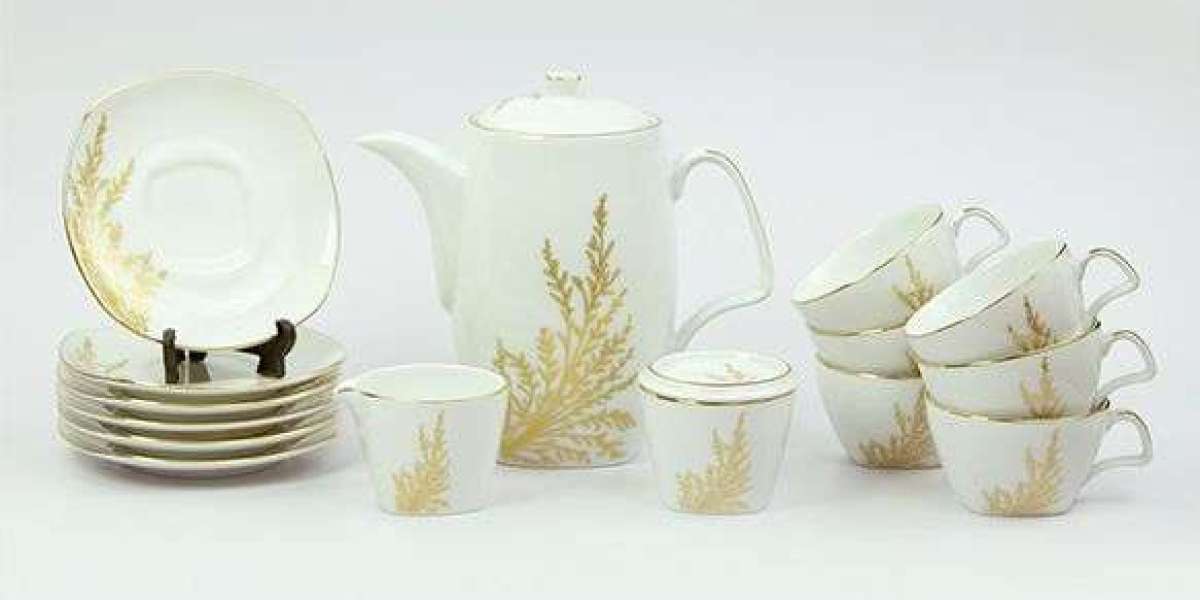Porcelain products are very popular among many people, whether it is for home use or to get employee gifts or corporate gifts in Sri Lanka, or gifts for wedding couples in Sri Lanka. Porcelain dinnerware and tea sets make great housewarming gifts too.
Porcelain is made through a process that involves the careful selection and blending of raw materials, followed by shaping, drying, glazing, and firing at high temperatures. Here is a step-by-step overview of how porcelain is made:
1. Raw Materials
● Kaolin: A type of pure white clay that is a key ingredient in porcelain, providing its plasticity and structure.
● Feldspar: A mineral that acts as a flux, helping the porcelain to vitrify (become glass-like) during firing.
● Quartz: Helps in stabilising the form and improving the translucency of the final product.
2. Preparation of Materials
● Mixing: The raw materials are finely ground and mixed together with water to form a smooth, pliable clay body. The proportions of kaolin, feldspar, and quartz are carefully controlled to achieve the desired properties in the final porcelain.
3. Shaping
● Moulding or Throwing: The clay body is shaped into the desired form using methods like hand-throwing on a potter’s wheel, slip casting in moulds, or pressing.
● Trimming and Detailing: After shaping, the porcelain piece may be trimmed, carved, or otherwise refined to enhance its design and finish.
4. Drying
● Air Drying: The shaped porcelain is allowed to dry slowly to reduce moisture content. This is a critical step to prevent cracking or warping during the subsequent firing process.
5. Bisque Firing
● Initial Firing: The dried porcelain is first fired in a kiln at a relatively low temperature (around 800-1000°C or 1470-1830°F). This bisque firing hardens the piece and makes it easier to handle for glazing.
6. Glazing
● Application of Glaze: A glaze, which is a glassy coating, is applied to the bisque-fired porcelain. The glaze can be applied by dipping, spraying, or brushing. Glazes can add colour, texture, and a glossy or matte finish to the porcelain.
7. Glaze Firing
● High-Temperature Firing: The glazed porcelain is fired again at a much higher temperature (typically 1200-1400°C or 2190-2550°F). This high-temperature firing causes the glaze to melt and form a smooth, glassy surface, while the porcelain itself vitrifies, becoming hard, dense, and translucent.
8. Cooling and Finishing
● Cooling: After firing, the kiln is gradually cooled to prevent thermal shock, which could crack or damage the porcelain.
● Inspection and Decoration: The finished porcelain is inspected for quality. Some pieces may undergo additional decoration, such as hand-painting, gilding, or the application of decals, followed by a final firing to fix these decorations.
9. Final Product
● Durable and Beautiful: The result is a durable, often translucent, and beautifully crafted piece of porcelain, prized for its strength, delicate appearance, and fine texture.
Porcelain making is a meticulous process that requires skill and precision at every step to produce the high-quality ceramics that have been valued for centuries.
How versatile is porcelain?
Porcelain is an incredibly versatile material, valued for its combination of strength, durability, beauty, and functionality. Its versatility is evident in its wide range of applications, which span from everyday objects to high-tech uses. Here are some key areas where porcelain's versatility is most apparent:
1. Tableware and Kitchenware
● Dinnerware: Porcelain is commonly used for making plates, bowls, cups, and serving dishes. Its non-porous surface is ideal for food use, as it does not absorb flavours or odours and is easy to clean.
● Cookware: Porcelain enamel is often applied to metal cookware, like cast iron, to create non-stick, easy-to-clean surfaces that are resistant to rust and corrosion.
2. Art and Decoration
● Sculptures and Figurines: Porcelain’s fine texture and ability to capture intricate details make it a popular medium for creating decorative sculptures and figurines.
● Vases and Decorative Objects: Porcelain is used to craft a wide range of decorative objects, from elegant vases to intricate ornaments, often featuring detailed hand-painted designs or glazes.
3. Building and Construction
● Tiles: Porcelain tiles are widely used in flooring, walls, and countertops due to their durability, water resistance, and low maintenance. They can be made in various colours, patterns, and finishes, mimicking the appearance of natural stone, wood, or other materials.
● Sanitaryware: Porcelain is the material of choice for sinks, toilets, and bathtubs due to its resistance to water, stains, and chemicals, as well as its easy-to-clean surface.
4. Industrial Applications
● Electrical Insulators: Porcelain’s excellent dielectric properties (its ability to act as an insulator) make it ideal for use in electrical insulators, especially in high-voltage applications where other materials might fail.
● Chemical Ware: In laboratories, porcelain is used for crucibles, evaporating dishes, and other vessels that need to withstand high temperatures and chemical reactions without reacting with the substances being processed.
5. High-Tech Applications
● Advanced Ceramics: In the field of advanced ceramics, porcelain is used in the production of components for electronics, medical devices, and even aerospace applications, where its high strength, thermal stability, and resistance to wear are crucial.
● Dental Prosthetics: Porcelain is commonly used in dental crowns, veneers, and bridges due to its natural appearance, biocompatibility, and durability.
6. Cultural and Historical Significance
● Antiques and Heirlooms: Porcelain has long been used to create items of cultural and historical significance, such as fine china, which is often passed down through generations as heirlooms.
● Museum Pieces: Many porcelain artefacts, especially those from ancient China, Europe, and other cultures, are valued as art pieces and are displayed in museums around the world.
7. Jewellery and Fashion
● Jewellery: Porcelain can be crafted into delicate jewellery pieces, such as beads, pendants, and earrings, often combined with other materials like gold or silver to create unique, wearable art.
● Buttons and Accessories: Small porcelain items like buttons, cameos, and other fashion accessories have been popular for centuries, adding a touch of elegance to clothing and personal adornment.
8. Environmental Adaptability
● Weather Resistance: Porcelain is highly resistant to environmental factors such as frost, UV rays, and acid rain, making it suitable for outdoor use in garden pots, statues, and tiles.
Porcelain’s versatility lies in its ability to be both functional and decorative, serving practical purposes while also being appreciated for its aesthetic qualities. Its adaptability across different fields and industries underscores its enduring appeal and usefulness.








